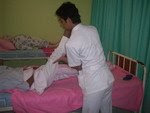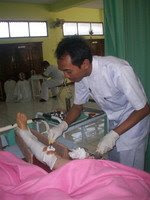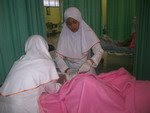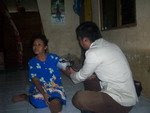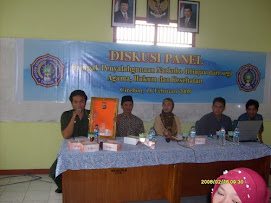Laurie Barclay, MD
Authors and Disclosures
August 25, 2009 — The World Health Organization (WHO) has issued guidelines for antiviral treatment for novel influenza A (H1N1) and other influenza. The purpose of the new recommendations, which were posted online August 20, is to provide a basis for advice to clinicians regarding the use of the currently available antivirals for patients presenting with illness caused by influenza virus infection, as well as considerations regarding potential use of these antiviral medications for chemoprophylaxis.
On the basis of a review of data collected with previously circulating strains, and treatment of human H5N1 influenza virus infections, the new guidelines expand on recommendations published in May 2009, titled ʺClinical management of human infection with new influenza A (H1N1) virus: Initial guidance." These new guidelines do not change recommendations in the WHO rapid advice guidelines on pharmacological management of humans infected with highly pathogenic avian influenza A (H5N1) virus.
"In April 2009, the [WHO] received reports of sustained person to person infections with [H1N1] virus in Mexico and the United States," write Edgar Bautista, from Médico Neumólogo Intensivista, Jefe de UCI-INER in Mexico, and colleagues. "Subsequent international spread led WHO to declare on 11 June 2009 that the first influenza pandemic in 41 years had occurred. This 2009 pandemic H1N1 influenza virus has now spread worldwide, with confirmed cases of pandemic H1N1 virus infection reported in more than 100 countries in all 6 WHO regions[, which] has led to the need to add to the existing guidance on the use of antivirals."
The new recommendations highlight oseltamivir and zanamivir, which are neuraminidase inhibitors, and amantadine and rimantadine, which are M2 inhibitors. Suggestions are also provided regarding the use of some other potential pharmacological treatments, such as ribavirin, interferons, immunoglobulins, and corticosteroids.
Management of patients with pandemic influenza (H1N1) 2009 virus infection is the primary focus of the statement, although it also includes guidance regarding the use of the antivirals for treatment of other seasonal influenza virus strains, as well as for infections resulting from novel influenza A virus strains.
The guidelines urge country and local public health authorities to issue local recommendations for clinicians periodically, based on epidemiological and antiviral susceptibility data on the locally circulating influenza strains. As the prevalence and severity of the current pandemic evolves, WHO anticipates that additional data will be forthcoming that may require revision of the current recommendations. WHO therefore plans to review the guidance no later than September 2009 to determine whether modifications to the recommendations are needed.
Recommendations for Antiviral Treatment of H1N1
For patients with confirmed or strongly suspected infection with influenza pandemic (H1N1) 2009, when antiviral medications for influenza are available, specific recommendations regarding use of antivirals for treatment of pandemic (H1N1) 2009 influenza virus infection are as follows:
* Oseltamivir should be prescribed, and treatment started as soon as possible, for patients with severe or progressive clinical illness (strong recommendation, low-quality evidence). Depending on clinical response, higher doses of up to 150 mg twice daily and longer duration of treatment may be indicated. This recommendation is intended for all patient groups, including pregnant women, neonates, and children younger than 5 years of age.
* Zanamivir is indicated for patients with severe or progressive clinical illness when oseltamivir is not available or not possible to use, or when the virus is resistant to oseltamivir but known or likely to be susceptible to zanamivir (strong recommendation, very low quality evidence).
* Antiviral treatment is not required in patients not in at-risk groups who have uncomplicated illness caused by confirmed or strongly suspected influenza virus infection (weak recommendation, low-quality evidence). Patients considered to be at risk are infants and children younger than 5 years of age; adults older than 65 years of age; nursing home residents; pregnant women; patients with chronic comorbid disease including cardiovascular, respiratory, or liver disease and diabetes; and immunosuppressed patients because of malignancy, HIV infection, or other diseases.
* Oseltamivir or zanamivir treatment should be started as soon as possible after the onset of illness in patients in at-risk groups who have uncomplicated illness caused by influenza virus infection (strong recommendation, very low quality evidence).
Recommendations for Chemoprophylaxis of H1N1
Specific recommendations regarding the use of antivirals for chemoprophylaxis of pandemic (H1N1) 2009 influenza virus infection are as follows:
* When risk for human-to-human transmission of influenza is high or low, and the probability of complications of infection is high, either because of the influenza strain or because of the baseline risk of the exposed group, use of oseltamivir or zanamivir may be considered as postexposure chemoprophylaxis for the affected community or group, for individuals in at-risk groups, or for healthcare workers (weak recommendation, moderate-quality evidence).
* Individuals in at-risk groups or healthcare personnel need not be offered antiviral chemoprophylaxis if the likelihood of complications of infection is low. This recommendation should be applied independent of risk for human-to-human transmission (weak recommendation, low-quality evidence).
For treatment of mild to moderate uncomplicated clinical presentation of infection with multiple cocirculating influenza A subtypes or viruses with different antiviral susceptibilities, patients in at-risk groups should be treated with zanamivir or oseltamivir plus M2 inhibitor (noting that amantadine should not be used in pregnant women). Otherwise-healthy patients with this presentation need not be treated.
When the clinical presentation of infection with multiple cocirculating influenza A subtypes or viruses with different antiviral susceptibilities is severe or progressive, all patients should be treated with oseltamivir plus M2 inhibitor, or zanamivir.
For treatment of mild to moderate uncomplicated clinical presentation of infection with sporadic zoonotic influenza A viruses including H5N1, the at-risk population should be treated with oseltamivir or zanamivir, and the otherwise-healthy population with oseltamivir. All patients, regardless of risk status, with severe or progressive presentation of infection with sporadic zoonotic influenza A viruses including H5N1 should be treated with oseltamivir plus an M2 inhibitor.
WHO Rapid Advice Guidelines on Pharmacological Management of Influenza Virus. Published online August 20, 2009.
29 Agustus 2009
10 Agustus 2009
Pandemic H1N1 (from Edhie S.)
The pandemic in a nutshell[1]:
The epidemiology: In 4 months of the pandemic it has spread to 168 countries, there are 160,000 confirmed cases and 1000 deaths, half of theml in the 25-50 age period. A CDC modelling - http://www.cdc. gov/H1N1flu/ surveillanceqa. htm - estimates 20 infected (most asymptomatic or very mild) cases per confirmed case, so in the US the case fatality rate is of approximately of 0,3 per thousand. The doubling rate is every three days but it's not clear how long and recurrent are the epidemic curves once a community is infected and transmission conditions exist (influenza seasonal outbreaks are normally 2-3 months). Higher risk groups are under 5s, pregnant women, health workers, patients suffering from chronic conditions and remote populations (less immunity to related strains).
Diagnosis/Monitorin g: recently, WHO has changed the guidance on reporting and given the magnitude, is not following on clab-confirmed cases but on clinical criteria. It will be difficult to have specific information as most cases are mild and recover without treatment.
Case management: besides the supportive treatment with oxygen and the complications' treatment with corticoids and antibiotics; H1N1 viruses are currently susceptible to the neuraminidase inhibitors oral oseltamivir (although there are some recent cases of resistance) and inhaled zanamivir. Clinical efficacy data are not yet available. WHO only guides that antiviral therapy may be beneficial for pregnant patients, patients with pneumonia and patients with underlying medical conditions.
The vaccine: The vaccine usable to immunize people, from one or more manufacturers is expected as next September. Production of seasonal influenza vaccines has been completed and full industrial production capacity is available for supply of pandemic vaccine in the months to come. There are currently around twenty vaccine manufacturers (70% production capacity in the EU and US) with licenses to produce seasonal influenza vaccines. The production capacity estimates are from 1 to 4.9 billion in 12 months. It is not yet clear it is determined whether one or two doses of the vaccine will be needed to achieve protection.. The indications are being discussed by the Strategic Advisory Group of Experts (SAGE) on Immunization and so far have recommended that health care workers worldwide should be immunized as a first and that national authorities will identify priority groups for vaccination based on circumstances within the country. WHO is discussing with the industry and with developed countries the challenge to allocate a share through donations or tiered prices to developing countries. There is no mechanism in place for global supply and distribution.
The main questions which await an answer:
1. What are the real magnitude and the distribution of the problem? In public health terms we need incidence (not known, although if applied globally, the CDC modelling would mean a global rate in the region on 3 million people. Africa , the worst-off region in health capacities and overall indicators, has only reported 200 cases with no deaths, but the underestimate might be greater in countries with poorer epidemiological surveillance structures.
The Influenza A pandemic is probably not a public health priority in sub-Saharan Africa : Even if half the population would be infected in the first and second seasonal waves of the pandemic (WHO estimates : given the estimated case fatality rate, the overall mortality in Africa, would be 90,000 deaths, possibly twice if under-nutrition is proven a mortality risk factor. Even in that range, the number of premature deaths would only be 15 times lower than from ARIs (acute respiratory infections), to which treatment only 40% of children have access to. Therefore, significant investments in responding to this health challenge should be weighed against other greater unmet health needs.
2. What is the adequate response? It seems that laboratory confirmation, neither for clinical management nor for monitoring/reportin g purposes is now essential. Case management is as in acute respiratory infections (ARIs) and –as mentioned earlier- the basic treatment for ARIs has a low accessibility, not to mention the recommendations of oxygen and steroids for complicated cases as recommended by WHO. The efficacy of antiviral therapy is still unclear, while some resistances are developing. In the seasonal flu logic, the vaccine will be safe and have 70-90% effectiveness in prevention rate, probably half in patients with risk factors (lower immune capacity). It is neither clear how many doses will be needed. At a current price of €10/vaccine (recent estimates of French 94 m doses order), with an average 70% effectiveness rate, the age groups affected, and targeting (as most countries in Europe are considering) under 5s, pregnant women health workers and chronically ill patients (possibly including HIV infected persons) –total 30% of the population-, the investment needed, only considering the vaccine costs (2 vaccines/person in those groups), would be € 1,8 b with a cost-utility (healthy life year saved) of €1800/DALY, some 36 times higher (more costly, less efficient) then many uncovered priority interventions such as bed nets, micronutrients, de-worming, EPI vaccines, ORS or even access to integrated IMCI (Integrated Management of Childhood Illnesses –mentioned as unmet priority in the Agenda for Action on MDGs- including ARIs.
The potential effective intervention is vaccination but the modelling shows its efficiency would probably be low : With the current epidemiological, clinical and therapeutic information (still missing clear guidance from WHO), the main needs would be to strengthen the access, diagnosis and adequate treatment of ARIs, within the wider integrated approaches of IMCI and IMAIs (Integrated Management of Childhood and Adult Illnesses) through the aligned and integrated support of health systems. With the present data, the efficiency of vaccine campaigns or integrated in routine services would be (only considering vaccine costs) low and would bear a high opportunity- cost.. Price reductions would of course increase efficiency but it would still need to be weighed against other unmet needs of populations.
3. What is the current and vs. the optimal process? At present, WHO is gathering epidemiological data and scientific evidence, but on the protocol and recommendations there are yet not very clear and concrete decisions (anti-virals to who, vaccines to who, how many and when) and some countries are going ahead with decisions (such as risk groups eligible for vaccination) . The support to countries is envisaged through the WHO Influenza A (H1N1) Global Pandemic Response Plan and the WHO Pandemic Pharmaceutical Facility which is still lack detailed information on costing/priorities/ procedures. One very important issue is how the vaccine stocks made available for solidarity with developing countries, will be pooled and channelled. Meanwhile, developed countries are in direct and confidential negotiations with the vaccine and antiviral producers semi-monopolizing the potential global production capacity. The equity check of this market dynamics are non-binding statements by some Pharma and developed countries of 10% donations to developing countries (with no fiscal space to address the pandemic and many other health needs' constrains), where most of the burden of disease will take place. In terms of the Pharma discovery and production, patent-holders are already challenges by lower prices by generics in India ( Roche's€ 40/ dose of 10 capsules vs. Cipla's € 15) and low middle-income have requested application of TRIPS flexibilities (and Argentiba and Brazil offering genric production capacity) considering Pandemic Flu vaccines and treatments as "global public goods" with the goal to "achieve coverage for the entire population.
WHO should continue its normative role and possibly be more concrete on recommendations, even if adjustable to country context, for vaccine and treatment protocols, despite of the uncertainty grounds. This decisions, together with epidemiological modeling would enable some costing of the response plans built on the IHR commitments and previous preparedness plans for avian flu, even if it could show (as suggested above) a low efficiency in the context of all health challenges in developing countries. If for the purpose of global control of the pandemic, support to developing countries is part of a global response with global benefit, then funding should come from additional sources then development funds and global health principles of transparency, equity and global governance should apply. A vaccine fund as the 2003 fund for meningitis vaccine, could enable equitable distribution of per countries.
The epidemiology: In 4 months of the pandemic it has spread to 168 countries, there are 160,000 confirmed cases and 1000 deaths, half of theml in the 25-50 age period. A CDC modelling - http://www.cdc. gov/H1N1flu/ surveillanceqa. htm - estimates 20 infected (most asymptomatic or very mild) cases per confirmed case, so in the US the case fatality rate is of approximately of 0,3 per thousand. The doubling rate is every three days but it's not clear how long and recurrent are the epidemic curves once a community is infected and transmission conditions exist (influenza seasonal outbreaks are normally 2-3 months). Higher risk groups are under 5s, pregnant women, health workers, patients suffering from chronic conditions and remote populations (less immunity to related strains).
Diagnosis/Monitorin g: recently, WHO has changed the guidance on reporting and given the magnitude, is not following on clab-confirmed cases but on clinical criteria. It will be difficult to have specific information as most cases are mild and recover without treatment.
Case management: besides the supportive treatment with oxygen and the complications' treatment with corticoids and antibiotics; H1N1 viruses are currently susceptible to the neuraminidase inhibitors oral oseltamivir (although there are some recent cases of resistance) and inhaled zanamivir. Clinical efficacy data are not yet available. WHO only guides that antiviral therapy may be beneficial for pregnant patients, patients with pneumonia and patients with underlying medical conditions.
The vaccine: The vaccine usable to immunize people, from one or more manufacturers is expected as next September. Production of seasonal influenza vaccines has been completed and full industrial production capacity is available for supply of pandemic vaccine in the months to come. There are currently around twenty vaccine manufacturers (70% production capacity in the EU and US) with licenses to produce seasonal influenza vaccines. The production capacity estimates are from 1 to 4.9 billion in 12 months. It is not yet clear it is determined whether one or two doses of the vaccine will be needed to achieve protection.. The indications are being discussed by the Strategic Advisory Group of Experts (SAGE) on Immunization and so far have recommended that health care workers worldwide should be immunized as a first and that national authorities will identify priority groups for vaccination based on circumstances within the country. WHO is discussing with the industry and with developed countries the challenge to allocate a share through donations or tiered prices to developing countries. There is no mechanism in place for global supply and distribution.
The main questions which await an answer:
1. What are the real magnitude and the distribution of the problem? In public health terms we need incidence (not known, although if applied globally, the CDC modelling would mean a global rate in the region on 3 million people. Africa , the worst-off region in health capacities and overall indicators, has only reported 200 cases with no deaths, but the underestimate might be greater in countries with poorer epidemiological surveillance structures.
The Influenza A pandemic is probably not a public health priority in sub-Saharan Africa : Even if half the population would be infected in the first and second seasonal waves of the pandemic (WHO estimates : given the estimated case fatality rate, the overall mortality in Africa, would be 90,000 deaths, possibly twice if under-nutrition is proven a mortality risk factor. Even in that range, the number of premature deaths would only be 15 times lower than from ARIs (acute respiratory infections), to which treatment only 40% of children have access to. Therefore, significant investments in responding to this health challenge should be weighed against other greater unmet health needs.
2. What is the adequate response? It seems that laboratory confirmation, neither for clinical management nor for monitoring/reportin g purposes is now essential. Case management is as in acute respiratory infections (ARIs) and –as mentioned earlier- the basic treatment for ARIs has a low accessibility, not to mention the recommendations of oxygen and steroids for complicated cases as recommended by WHO. The efficacy of antiviral therapy is still unclear, while some resistances are developing. In the seasonal flu logic, the vaccine will be safe and have 70-90% effectiveness in prevention rate, probably half in patients with risk factors (lower immune capacity). It is neither clear how many doses will be needed. At a current price of €10/vaccine (recent estimates of French 94 m doses order), with an average 70% effectiveness rate, the age groups affected, and targeting (as most countries in Europe are considering) under 5s, pregnant women health workers and chronically ill patients (possibly including HIV infected persons) –total 30% of the population-, the investment needed, only considering the vaccine costs (2 vaccines/person in those groups), would be € 1,8 b with a cost-utility (healthy life year saved) of €1800/DALY, some 36 times higher (more costly, less efficient) then many uncovered priority interventions such as bed nets, micronutrients, de-worming, EPI vaccines, ORS or even access to integrated IMCI (Integrated Management of Childhood Illnesses –mentioned as unmet priority in the Agenda for Action on MDGs- including ARIs.
The potential effective intervention is vaccination but the modelling shows its efficiency would probably be low : With the current epidemiological, clinical and therapeutic information (still missing clear guidance from WHO), the main needs would be to strengthen the access, diagnosis and adequate treatment of ARIs, within the wider integrated approaches of IMCI and IMAIs (Integrated Management of Childhood and Adult Illnesses) through the aligned and integrated support of health systems. With the present data, the efficiency of vaccine campaigns or integrated in routine services would be (only considering vaccine costs) low and would bear a high opportunity- cost.. Price reductions would of course increase efficiency but it would still need to be weighed against other unmet needs of populations.
3. What is the current and vs. the optimal process? At present, WHO is gathering epidemiological data and scientific evidence, but on the protocol and recommendations there are yet not very clear and concrete decisions (anti-virals to who, vaccines to who, how many and when) and some countries are going ahead with decisions (such as risk groups eligible for vaccination) . The support to countries is envisaged through the WHO Influenza A (H1N1) Global Pandemic Response Plan and the WHO Pandemic Pharmaceutical Facility which is still lack detailed information on costing/priorities/ procedures. One very important issue is how the vaccine stocks made available for solidarity with developing countries, will be pooled and channelled. Meanwhile, developed countries are in direct and confidential negotiations with the vaccine and antiviral producers semi-monopolizing the potential global production capacity. The equity check of this market dynamics are non-binding statements by some Pharma and developed countries of 10% donations to developing countries (with no fiscal space to address the pandemic and many other health needs' constrains), where most of the burden of disease will take place. In terms of the Pharma discovery and production, patent-holders are already challenges by lower prices by generics in India ( Roche's€ 40/ dose of 10 capsules vs. Cipla's € 15) and low middle-income have requested application of TRIPS flexibilities (and Argentiba and Brazil offering genric production capacity) considering Pandemic Flu vaccines and treatments as "global public goods" with the goal to "achieve coverage for the entire population.
WHO should continue its normative role and possibly be more concrete on recommendations, even if adjustable to country context, for vaccine and treatment protocols, despite of the uncertainty grounds. This decisions, together with epidemiological modeling would enable some costing of the response plans built on the IHR commitments and previous preparedness plans for avian flu, even if it could show (as suggested above) a low efficiency in the context of all health challenges in developing countries. If for the purpose of global control of the pandemic, support to developing countries is part of a global response with global benefit, then funding should come from additional sources then development funds and global health principles of transparency, equity and global governance should apply. A vaccine fund as the 2003 fund for meningitis vaccine, could enable equitable distribution of per countries.
Langganan:
Postingan (Atom)

